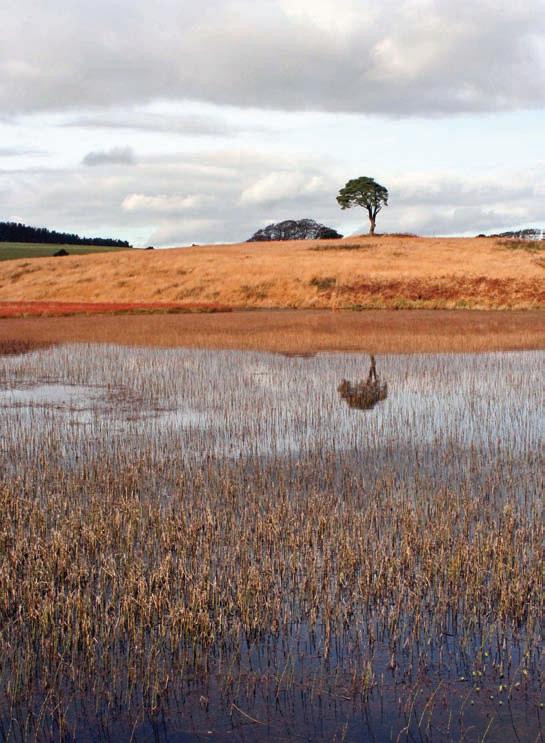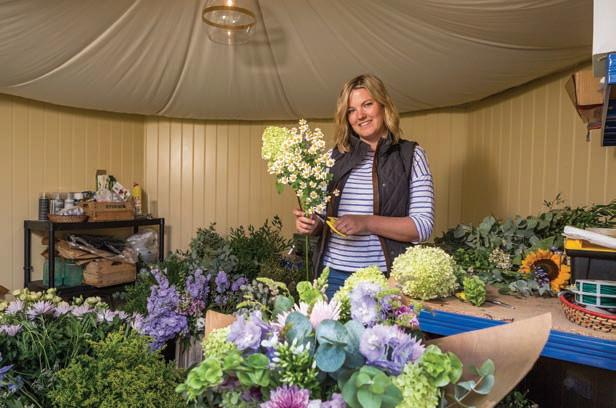
15 minute read
GREAT OUTDOORS

Old town road
Advertisement
It seems curious to Andrew Swift that, while lost railways and canals are well documented and recalled with affection, there is far less interest in lost roads. Yet it is still possible, with a bit of judicious map reading, to take a trip back in time along the old way to Wells, for example, and even to call into a few of its wayside hostelries
While most Bristolians will be familiar with the New Wells Road, the Old Wells Road, which it superseded, is virtually forgotten, even though it was probably as old as the two cities it linked, if not older. Surprisingly, the old road was a good deal shorter than the new one – 16 miles as opposed to 20. The reason it was abandoned was because it was a switchback, crossing the hills en route instead of skirting them. This was fine when the only road users were teams of packhorses or travellers on horseback, but impractical when stagecoaches came along. Information on the old road comes mainly from old maps. The first national road atlas, produced by John Ogilby in 1675, reveals that it was not just the way to Wells. If you wanted to travel to Exeter or Weymouth from Bristol, you went this way as well. Other maps, such as one published in 1708 by Herman Moll, continued to show it as the only road heading south from Bristol. From around 1750, however, maps also showed the new Wells Road, running through Whitchurch, Pensford, Farrington Gurney and Chewton Mendip. By the 1780s the old road rarely featured on maps at all.
When railways and canals are abandoned they tend to disappear, often completely. Abandoned roads, though, usually survive as country lanes or byways. It is still possible, with a bit of judicious map reading, to take a trip back in time along the old road to Wells, and even to call into a few of its wayside hostelries. Crossing Bristol Bridge, travellers bound for Wells turned right along Redcliff Street, continuing up Redcliff Hill and on through the village of Bedminster. With the exception of the pedestrianised part of East Street, you can still follow this route by car today. Then began the climb to Bedminster Down, a wild and lonely spot where solitary travellers risked being waylaid by footpads. The Wells road branched off the Bridgwater road at the Cross Hands Inn, to drop down to Bishopsworth – then known as Bishport – where an early-18th-century manor house and old farmhouses still bear witness to past prosperity.
Beyond Bishopsworth lay little except Withywood Farm and a handful
of cottages, until you reached the foot of Broad Oak Hill, up which the narrow road still corkscrews as it did centuries ago. As you climb, the views back over Bristol are still as fantastic, although stopping to appreciate them is nigh impossible. As the road levels out, you pass a cluster of houses which once included the Maidenhead Inn, with seven bedrooms and large stables. It closed around 1820, when the Carpenter’s Arms – now Carpenter’s Tavern (BS41 8NE) – opened across the road.
This area was also a haunt of footpads. On one June evening in 1814, a farmer from Chew Magna, returning from Bristol Market, was held up on this road. When he jumped down from his cart to confront his assailant, he was shot through the head.
As the road starts descending, there is a superb view over Chew Valley Lake before the old road takes the right-hand fork to drop down Limeburn Hill to Portbridge Mill – now with a Bristol Gorilla in its garden. There follows another climb up Pagans Hill – its name derived from a local landowner called Pegnes – before dropping down into Chew Stoke, formerly known as Bishop’s Chew.
The road into the village today is not the original one. That ran to the west, crossing a narrow packhorse bridge which still survives. The Stoke Inn (BS40 8XE) was first recorded in 1657, but sadly the thatched hostelry recorded in a mid-19th century painting has since been replaced by the current building. After climbing out of the village, the road starts descending, deviating from the course of the old road which now lies under the waters of Chew Valley Lake. As it crosses a causeway, there is a lay-by with a view over the lake. Popular with bird watchers, it also attracts crowds at times of drought, when the old road, along with the parapets of a little bridge, resurfaces.
Soon, the diversion ends and the old road carries on to the Blue Bowl Inn (BS40 6HJ), once famous for the Bowl Revel held on the eve of Priddy Fair, when drinking – and a good deal else – went on through the night. Stratford Lane, which branches off here, follows the course of a Roman road along which lead was carried from the Mendip mineries.
Half a mile past the Blue Bowl, the Old Wells Road crosses the main road (following signs for Cheddar at this point) to begin the assault on Mendip, and the most spectacular part of the journey. Passing the Wellsway Inn, the gradient eases, but the climb continues as you pass Gibbett’s Brow, where those sentenced to death at Wells Assizes were brought to be hanged. At a lonely crossroads further on is the Castle of Comfort inn (BS40 6DD), so called because those on their way to the gibbet stopped there for a final drink.
As you carry straight on, you pass Castle Farm, where another Roman road crossed. At the next crossroads was the Miner’s Arms, a little way along on the right. Although long closed, a miner’s lamp still hangs on its wall. In the 1960s it achieved fame as the unlikeliest of gastropubs after the landlord started serving a delicacy called ‘Mendip Wallfish’ – or local snails. It was also home to one of England’s first microbreweries.
A little further on the right is Waldegrave Pond which supplied water to the Priddy mineries. On the left is a Forestry Commission car park, from where you can explore Stockhill Woods, laid out in disused quarries, or cross the road to follow the course of an old tramway through the old leadworks. Three-quarters of a mile further is Hunter’s Lodge (BA5 3AR) many people’s all-time favourite pub and possibly the most famous cavers’ pub in Britain. The bleakness of its exterior belies the warmth of what has to be one of the friendliest and least-changed pubs in Somerset –local beer and cider from barrels behind the bar, traditional home-cooked food, dogs and walkers welcome – although mobile phones aren’t, and it’s strictly cash only. And if you’re wondering about what appears to be a wishing well in the car park, it’s actually the entrance to a cave called Hunter’s Hole.
The signpost at Hunter’s Lodge indicates a left turn for Wells, via a more amenable route, but having followed the old road thus far it would be a pity to abandon it now. As you carry on, the road runs straight and true for another half mile, before plummeting down the narrowest corkscrew yet, to enter Wells along Sadler Street, lined with old inns –some still open – before arriving in the Market Place. ■
Waldegrave Pond

THE KI TC HE N PA R TNER S
D E S I G N S T U D I O
Remote Kitchen Design Service Available Call or email for further details 01179 466433 • studio@thekitchenpartmers.co.uk


Inspirational kitchens, practical living
www.thekitchenpartners.co.uk 102 Whiteladies Road, Clifton, Bristol BS8 2QY | 01179 466433
Founders and Lead Designers - Fiona & Clinton
50% OFF INSTALLATION see in store for details
The gre at outdoors

Shedworking and outdoor living spaces have become increasingly popular as people look to reduce their commute to work or simply long to be closer to nature. Garden Affairs, specialists in designing studio gardens, have recently introduced a new range with an innovative new material that’s set to revolutionise the genre
Do you have a garden room dream? Imagine if the only commute to work was a few strides across the lawn. Would an outdoor studio where you could easily pop back to your desk in the evening to complete a project suit you? Would a view of trees and plants from your window make your everyday routine that little bit more golden? Or rather green?
Shedworking is nothing new, of course. Tourists still flock to the wooden boathouse in Laugharne used by Welsh writ er Dylan Thomas, and to sculptor Barbara Hepworth’s summerhouse and studio in St Ives, Cornwall. Roald Dahl famously retreated to his writing shed to dream up the vivid characters of his much-loved children’s books. Playwright George Bernard Shaw had a garden room that could be rotated as the sun moved around. Contemporary garden room enthusiasts include property guru Kirstie Allsopp, who has said that h er wooden garden room reminds her fondly of the tree houses her father built for her as a child. Canny Kirstie also points out that having an extra room at your property will enhance its value.
Perhaps this is the real creative appeal of the outdoor studio. We know a well-built garden room is economical, secure, quick to install and easy to heat, and that we can incorporate all our customised storage, ta bles, lighting, modern kilns and so on. But even these practical reasons don’t account for so many artists and writers loving them so much.
It’s clear that a timber garden studio offers serious benefits, but it’s not a serious place to be. It’s a space to play, to experiment, to remember childhood and invent new worlds. Artists and sheds go together like paint and canvas. A creative cabin is where magic happens. West Country-based family-run business Garden Affairs helps people achieve their garden room dreams by consulting with them to design bespoke living spaces. Each cabin is as unique as its owner and people are free to create their own world inside.
The Garden Affairs team, based just outside Bath in Trowbridge, has been able to help all kinds of creative people set up their own space in their gar dens. The design team can advise on everything from the position and size of the garden room to supplying electricity and lighting, as
ABOVE: the Proline range offers a crisp finish to the interior of the garden room, making it an ideal place to watch the garden bloom this spring
OPPOSITE: top two images, the ecofriendly cabins are well insulated and designed to retain warmth and stay cool at the desired times and unique styles, shapes and designs are used for every customer
OPPOSITE: bottom two images, the cabins can be used as both offices and workshops
well as whether your home project will need planning permission. The latest generation of wooden cabins is eco-friendly, well insulated and designed to retain warmth in winter and stay cool on hot summer days. There is even an option to plant a sedum roof to encourage wildlife, and to add a water butt to collect rainwater from the guttering.
Constantly reassessing the design of their garden rooms to off er the very latest offerings, Garden Affairs have recently introduced a range of garden rooms called Proline that uses a brand new, sustainable construction material called Tricoya. This is an exceptionally stable, modern wood composite with a 25-year life that copes effortlessly with all outdoor weather conditions. The material is also guaranteed to not rot or warp, and unlike other garden rooms, it is resistant to fungal attack. The range offers design flexibility and low-maintenance costs, but also a stability and durability that is new to the outdoor room market.
Whether customers are looking to install a home gym or a relaxing outdoor living space to both physically and mentally escape the working week, the Proline range does not compromise the style of the building and focuses on the appearance and performance of the room. Its vertical tongue-and-groove effect also gives it a crisp, clean exterior. Created using computer-controlled manufacturing, the Proline is quick and easy to assemble for both professional and DIY installers.
This latest range marks a huge step forward in the world of garden rooms: exceptional stability, a totally rot-proof structure and stylish good looks. There’s your gar den dream.
CASE STUDIES
An artist’s studio Max Ryan wanted a studio where she could run art classes and operate her picture framing and photography business. She didn’t want the expense and hassle of having to rent a studio where she would have to commute, so enquired about installing a large log cabin in her garden in Frome. Max chose a substantial cabin, nine metres wide and four metres deep, with windows and th ree additional skylights. Inside, along with the main studio space, two smaller rooms were created for a cloakroom and a private office. Max’s business, Studio 61, is now well established and she says she relishes the short commute and the fact that she can take her dog Howard to work with her. The studio is so warm and comfortable that she has even been able to run life-drawing classes for her students .
The ceramicist Lizzie wanted a studio she could devote to her passion for pottery. After discussing how she needed to use the space, she had a 3.5 x 2.5 metre workshop designed, into which Lizzie introduced her home kiln, which is run by electricity. She also arranged for a plumber to supply water to the workshop, for a handy sink, and opted for a bee-friendly living sedum roof. n




T H E BRISTOL M A G A Z I N E
The city directory of small businesses that are big on service
To be featured in this section call us on 0117 974 2800 or email sales@thebristolmagazine.co.uk


Accountancy Architects
BOOKKEEPING SERVICES Tailored to suit your business needs.
• Quickbooks, Kashflow, Xero and Sage • • MTD compliant VAT returns • • Data entry and bank reconciliations • • Management reports •
Qualified and governed by The Institute of Certified Bookkeepers
Contact us on 07749 564397 enquiries@beaumontbookkeeping.com www.beaumontbookkeeping.com
Simon Corbett ARCHITECT
Small local practice with 5 Star Google and Houzz reviews Call Simon to discuss your project on 07969 607913
Electrical

House & Home

WOULD YOU LIKE YOUR OVEN CLEANED UNTIL IT GLEAMS?

We come to your home and deep clean your oven, Aga, range, hob or extractor using our eco-based cleaning process that is safe for everyone including asthmatics, children and your pets.
“Very pleased, once again, with the clean oven I was left with yesterday. My Neff oven is 23 years old but now looks very young again! Have been using OvenGleamers for years and very happy with the service.”
Mrs Jennings, Bristol, Jan 2020
Call 01666 822 060 Email: info@simplystairlifts.co.uk Web: simplystairlifts.co.uk Independent family run business with family values • New and Reconditioned • Warranty Contracts • Straight and Curved Stairlifts • Services and Repairs • Rental Stairlifts • Removals Create your home for life



How would you like someone to help you with your Cleaning and Ironing?
“I have found your service helpful, friendly and efficient and my cleaner has a first class cleaning ability and a pleasing personality.” Mrs Allwood, Henleaze
Weekly, Fortnightly or One-Off Cleaning Services
Call Jane today on Bristol 0117 325 3354 www.homegleamers.co.uk Providing Cleaners for Homes since 2004
Elly’s Wellies Garden Designs

BUYING CARPET & FLOORING IN BRISTOL MADE SIMPLE Welcome to The Carpet Barn in Bristol. We have one of the largest selection of carpets, laminate, vinyland Karndeanflooring in Bristol and the South West region. Our flooring showroom is conveniently situated at Longwell Green Bristol with free parking; so when buying your next carpet or flooring, why not come and experience our wide range, first class fitting service and great prices for yourself? You‘ll be spoilt for choice with our wide range of carpets and flooring...


FITTING AND DELIVERY SERVICE

Find us at: The Old Coachworks, Bath Road, Longwell Green, Bristol, BS30 6DL
Telephone: 0117 947 7721


Visit us online: thecarpetbarn.co.uk
Turning your ideas into beautiful spaces

Elly’s Wellies Garden Designs will help you maximise the potential of your outdoor space and tailor it to your individual needs. Whether you are looking for a complete garden redesign, or just need advice on what to plant in a border, Elly’s Wellies will be happy to help.
For a free initial consultation, contact Elly West











